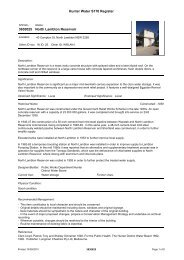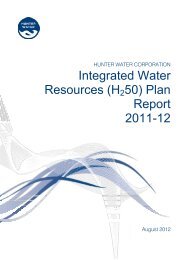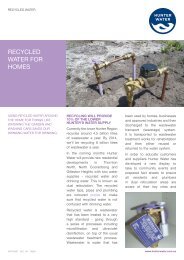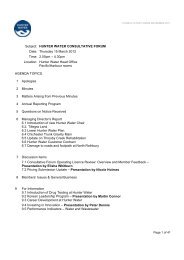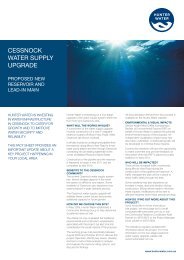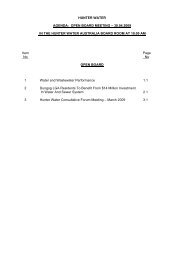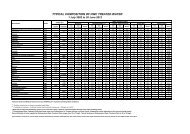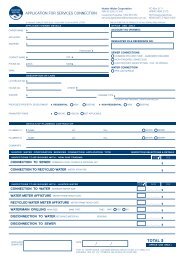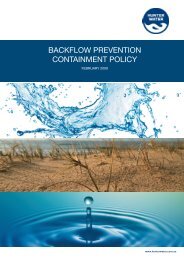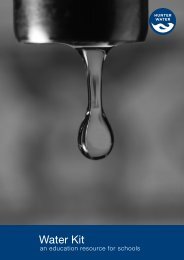Catchment Management Plan Overview - Hunter Water
Catchment Management Plan Overview - Hunter Water
Catchment Management Plan Overview - Hunter Water
- No tags were found...
You also want an ePaper? Increase the reach of your titles
YUMPU automatically turns print PDFs into web optimized ePapers that Google loves.
<strong>Catchment</strong><strong>Management</strong> <strong>Plan</strong>An overview of <strong>Hunter</strong> <strong>Water</strong>’s plan for our catchments<strong>Catchment</strong> <strong>Management</strong> <strong>Plan</strong> – An <strong>Overview</strong> – 1
IntroductionA safe AND RELIABLE water supply beginsin our catchments. The quality of the water stored in ourdams and sandbeds greatly affects the quality and cost ofthe water delivered to the community.<strong>Hunter</strong> <strong>Water</strong> has developed a long term <strong>Catchment</strong><strong>Management</strong> <strong>Plan</strong> for protecting and improving water qualityin our rivers and catchments.The plan identifies activities that can be better controlled tomanage risks to drinking water quality from climate change,development and population growth in a rapidly growingLower <strong>Hunter</strong>.Managing the <strong>Hunter</strong>’s catchments requires effectivecollaboration between a range of stakeholders including<strong>Hunter</strong> <strong>Water</strong>, the <strong>Catchment</strong> <strong>Management</strong> Authority, localgovernments, regulators, the agricultural sector, landownersand the community.<strong>Hunter</strong> <strong>Water</strong>’s role is to focus on ensuring our communityhas access to safe and reliable drinking water. We arefocused on building strong partnerships to keep ourcatchments clean.The <strong>Catchment</strong> <strong>Management</strong> <strong>Plan</strong> provides clear prioritiesfor sustainable catchment management and collaborationacross stakeholder groups to ensure safe drinking water forour region.The eight element <strong>Catchment</strong> <strong>Management</strong> <strong>Plan</strong>A wide review of other water authorities, regulations and waterquality management guidelines revealed that Australian andinternational leaders in catchment management effectivelyimplement eight principles. <strong>Hunter</strong> <strong>Water</strong> intends to implementthese elements to minimise water quality risks in our catchments.The plan promotes future planning in three time horizons –short term, medium term and our vision for the future. It willbe reviewed every four years in consultation with catchmentstakeholders as understanding of our catchments develops andnew recommended practices emerge.Element 1: Identify the top hazardsElement 2: Have effective legislationElement 3: Work with stakeholdersElement 4: Monitor high risk areasElement 5: Foster researchDominant elementElement 6: Perform proactive surveillanceSupporting elementElement 7: Engage the communityElement 8: <strong>Plan</strong> for emergenciesElement has a stronginfluence on anotherThis influence diagram demonstrates the connections between the eight elements in <strong>Hunter</strong> <strong>Water</strong>’s <strong>Catchment</strong> <strong>Management</strong> <strong>Plan</strong>.2 – <strong>Catchment</strong> <strong>Management</strong> <strong>Plan</strong> – summary An <strong>Overview</strong> document
Element 1: Identify the top hazardsOur objectiveTo develop a better understanding of our catchmentsso we can make informed decisions about their futuremanagement.Poultry farms in a catchment.How we will do itAfter researching the various methods to identify and rankthe hazards of catchments and the potential impact towater quality, <strong>Hunter</strong> <strong>Water</strong> has adopted an innovativeGIS based catchment model developed by the Sydney<strong>Catchment</strong> Authority.This model is the foundation on which we make decisionsabout our catchment priorities and will involve a map ofareas that theoretically pose the highest pollution risk towater reserves.The maps are created in a user friendly format with astrong scientific basis. Initial tests on the Grahamstown<strong>Catchment</strong> have produced maps that are similar to ouron-ground experience.<strong>Hunter</strong> <strong>Water</strong> aims to have determined the most significantwater quality hazards in catchments, ranked the prioritiesand scoped remediation work by 2013.The catchment model will allow remediation effort tobe addressed in priority order and ensure that it is costeffective.Key outcomesThe top catchment priorities areranked using the catchment modeland funding to address catchmentpriorities is requested in <strong>Hunter</strong><strong>Water</strong>’s 2013 price submission.Priority risk areas are sequentiallyaddressed with on-ground work,ongoing stakeholder engagement andcommunity education programs. Themodel is continually refined and rerun.The catchment model becomesan industry leading package and isintegrated into many land use changedecision making processes. Improvedland use practices are reflected inreduced hazards identified by thecatchment model.Short term 2011 - 2013 Medium term 2013 - 2017 Our vision for the future 2017 – beyond4 – <strong>Catchment</strong> <strong>Management</strong> <strong>Plan</strong> – An <strong>Overview</strong>
Element 2: Have effective legislationOur objectiveTo strengthen legislation in the drinking water catchment toensure that land is managed with a focus on water qualityprotection to minimise risk.How we will do itEffective legislation refers not only to the strength andclarity of the rules governing catchment land use, but alsotheir integration into local planning.The consequences of improper development control incatchments include increased risk and cost to consumers.<strong>Hunter</strong> <strong>Water</strong> will clarify the legislation throughimprovements to the <strong>Hunter</strong> <strong>Water</strong> Regulation 2010. Wewill also work to integrate this legislation into local planningand processes over the next two years.We will also continue to investigate other opportunities forincreased protection through effective legislation tools.Key outcomesThe <strong>Hunter</strong> <strong>Water</strong> Regulation 2010becomes embedded in planninginstruments and source waterquality is regularly considered inplanning decisions.<strong>Hunter</strong> <strong>Water</strong>, councils and NSWDepartment of <strong>Plan</strong>ning work closely inlocal and regional land use assessmentprocesses, including implementationof best practice stormwater treatmentrequirements.Integration of legislation into local andregional planning instruments meanssignificant land use changes alwaysapply best practice assessment tools tominimise the impact on receiving water.Short term 2011 - 2013 Medium term 2013 - 2017 Our vision for the future 2017 – beyondPossible impacts of inappropriate development controlsIncreasein the difficultyof maintainingeffectivetreatmentIncreasein risk ofpollutantsenteringtreatmentsystemIncreasein healthrisk toconsumersIncreasein cost andcomplexityof watertreatmentAbandonmentof catchmentsin extremecasesDecreasein thereliability ofthe watersource<strong>Catchment</strong> <strong>Management</strong> <strong>Plan</strong> – An <strong>Overview</strong> – 5
Element 3: Work with stakeholdersOur objectiveTo promote partnerships across stakeholder groups formore effective management of drinking water catchments.How we will do itStakeholders in the management of the total water cycle,not only the traditional service components such aswater delivery and stormwater, must work together incatchments to improve water quality.<strong>Hunter</strong> <strong>Water</strong> currently has good relationships witha diverse range of catchment stakeholders, havingrepresentatives on several committees throughoutthe region.We will build on current stakeholder relationships throughongoing consultation with the aim of furthering all elementswithin this plan. New stakeholders will be identified andrelationships built upon.Swamp in the Tilligerry State Conservation Area, within theTomago Sandbeds <strong>Catchment</strong>.Balikera Pump Station, Grahamstown Dam.Key outcomesDiscussions held between a broadrange of stakeholders reveals theconnections that can be leveragedin catchments and promotesdrinking water catchment issues.Stakeholder connections are enhancedand <strong>Hunter</strong> <strong>Water</strong> begins to influenceland use activities in catchments.Drinking water catchments areconsidered in all aspects of townplanning, from local scale land useplanning to regional master planning.Short term 2011 - 2013 Medium term 2013 - 2017 Our vision for the future 2017 – beyondAerial of Grahamstown Dam.6 – <strong>Catchment</strong> <strong>Management</strong> <strong>Plan</strong> – An <strong>Overview</strong>
Element 4: Monitor high risk areasOur objectiveTo ensure that <strong>Hunter</strong> <strong>Water</strong>’s water quality monitoringprogram effectively detects changes in source waterquality.How we will do it<strong>Water</strong> treatment plants are designed to remove all harmfulpollutants from the source water. It is essential to identifyand monitor the highest pollution risks in catchments sothat treatment plants can be appropriately designed.A good monitoring program also allows change over timein various parts of the catchments to be tracked.<strong>Hunter</strong> <strong>Water</strong> will continue to maintain widespread baselinesampling, adding targeted samples of runoff from rainevents at sites that pose the highest risk in catchments.Campvale Canal, Medowie.Illegal dumping of vehicle in Grahamstown <strong>Catchment</strong>.Key outcomesComplete peer reviewed Source<strong>Water</strong> Monitoring Program thatoptimises data collection andaligns monitoring with high riskareas.The Source <strong>Water</strong> MonitoringProgram is fully implemented with theappropriate mix of regular and eventsampling; data is easily stored andretrieved using GIS based technology.<strong>Catchment</strong> data collection is routinelyreviewed to analyse the highest risks;data storage is spatially referenced andeasily extracted by all stakeholders.Short term 2011 - 2013 Medium term 2013 - 2017 Our vision for the future 2017 – beyondErosion, Upper Chichester River.<strong>Catchment</strong> <strong>Management</strong> <strong>Plan</strong> – An <strong>Overview</strong> – 7
Element 5: Foster researchOur objectiveTo better pursue collaborative funding opportunities fortargeted local catchment research.How we will do itOur understanding of catchments changes over timeas the population grows and science improves. It isessential to be involved in national and local catchmentresearch to have quality information that enablesinformed decisions.<strong>Hunter</strong> <strong>Water</strong> will endeavour to direct catchmentresearch towards priority knowledge gaps, in particularland use and water quality data. We will have a researchand development program that leverages our localuniversity and those organisations with expertise incatchment management.It is envisaged that within the next few years theoutcomes of the catchment model will significantly informcatchment research priorities.Groundwater level research, North Stockton <strong>Catchment</strong>.Key outcomesResearch of identified knowledgegaps in catchments is promoted,particularly at the University ofNewcastle, focusing on informingthe catchment model.Specific funding is allocated to identifiedareas of need and the outcomes beginto inform management decisions.Collaborative funding opportunities areleveraged; drinking water catchmentresearch is a scientific focus at theUniversity of Newcastle.Short term 2011 - 2013 Medium term 2013 - 2017 Our vision for the future 2017 – beyondThe Tomago Sandbeds is home to some unique vegetation communities.8 – <strong>Catchment</strong> <strong>Management</strong> <strong>Plan</strong> – An <strong>Overview</strong>
Element 7: Engage the communityOur objectiveTo inform, connect with and empower the community tomake a positive change in catchments.How we will do it<strong>Hunter</strong> <strong>Water</strong>’s catchments are approximately 65 per centprivately owned. It follows that land users have arguablythe greatest ability to make a difference to water quality incatchments.We have begun to implement methods to inform andengage the community, including the development of a<strong>Catchment</strong> Communication <strong>Plan</strong> with the assistance ofother catchment stakeholders.Key outcomes<strong>Catchment</strong> signage andeffective media opportunitiesare identified; opportunities topromote catchment managementinformation are supported.<strong>Catchment</strong> signage and effectivemedia opportunities are resourced;community becomes more connectedwith drinking water catchments.The community is empowered to makepositive change to their activities incatchments and is supportive of <strong>Hunter</strong><strong>Water</strong>’s catchment initiatives.Short term 2011 - 2013 Medium term 2013 - 2017 Our vision for the future 2017 – beyond10 – <strong>Catchment</strong> <strong>Management</strong> <strong>Plan</strong> – An <strong>Overview</strong>
Element 8: <strong>Plan</strong> for emergenciesOur objectiveTo mitigate the risk of uncontrolled bushfire causing injury,damage or loss of water supply.How we will do itIn the future, it is likely that South-Eastern Australia will seelarger and more frequent bushfires due to the increase infire-weather risk brought about by global warming.<strong>Water</strong> from areas recently burnt by a bushfire can bedifficult and expensive to treat to drinking water standard.In addition, the forested catchments have valuable andcritical water assets such as borefields treatment plantsthat need protection from bushfire.An expanded Bushfire <strong>Management</strong> <strong>Plan</strong> (BMP) thatsets out best practice in relation to fire preparedness,emergency response and catchment recovery will bedeveloped to address the risk of bushfires.This plan will complement <strong>Hunter</strong> <strong>Water</strong>’s IncidentResponse <strong>Plan</strong> and other regional management plans.Key outcomesA Bushfire <strong>Management</strong> <strong>Plan</strong>(BMP) that focuses on threeareas – <strong>Hunter</strong> <strong>Water</strong>’s bushfirepreparedness, response during afire and post bushfire recovery.The BMP is accepted and endorsed byall parties in the region; mock incidentsare run.The BMP is integrated into allother regional bushfire plans, otherstakeholders are engaged in modifyingits structure and it is methodicallytested.Short term 2011 - 2013 Medium term 2013 - 2017 Our vision for the future 2017 – beyond<strong>Catchment</strong> <strong>Management</strong> <strong>Plan</strong> – An <strong>Overview</strong> – 11
Cover image: Paterson Gorge, Upper Paterson River.Photo above: Aerial of Grahamstown Dam.12 – <strong>Catchment</strong> <strong>Management</strong> <strong>Plan</strong> – An <strong>Overview</strong><strong>Hunter</strong> <strong>Water</strong> CorporationABN 46 228 513 446Customer Enquiries 1300 657 657enquiries@hunterwater.com.auwww.hunterwater.com.auPO Box 5171HRMC NSW 231036 Honeysuckle DriveNewcastle NSW 2300




